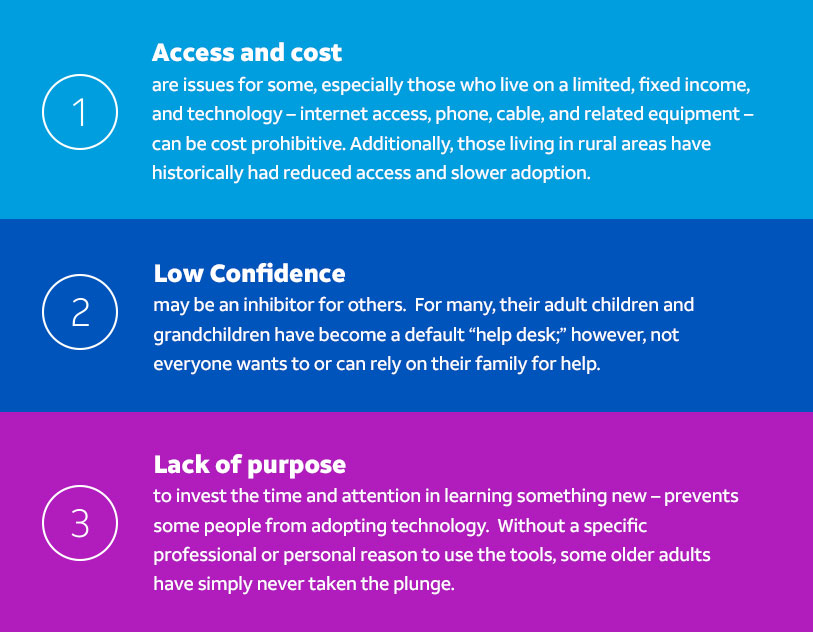For every wedding, graduation or birthday party that moved to Zoom in 2020, there was a grandparent who missed it because they didn’t have internet fast enough to support videoconferencing. For every book club or religious service that shifted online, someone was left out for lack of a smartphone.
And, as convenient as virtual doctor visits and online vaccine appointment scheduling are for the connected, they can pose insurmountable barriers for those on the wrong side of the digital divide.
Older adults are the least likely demographic to be online in 2021 — by a wide margin. In fact, age is a greater predictor of access than race, socioeconomic group, education level or geographic location. In the United States, 25% of adults over 65 report not using the internet at all.1 Only 65% of this age group have broadband at home2, and their smartphone use, at 61%, is lower than any other demographic.3
According to Angela Jones, of AT&T’s Advisory Panel on Access and Aging and Bright Horizons, there are 3 primary reasons why older adults may not bridge the digital divide:
Meeting the needs of older adults means acknowledging and accounting for diversity in terms of their technology literacy and access. While most adults over 65 use technology and have done so for many years, a substantial minority have never had the need or opportunity to adopt it.
For the digitally adept, technology makes life more convenient, safe and connected. Importantly, it can enable older adults to retain more control in how and where they live for longer. According to Angela, the pandemic accelerated positive outcomes by years among the 50+ population who have access to information and tools. Others fell further behind.
Bridging that divide requires breaking down multiple barriers that keep technology out of the hands of very people it could benefit most.
4 simple ways to bridge the gap and expand access
The simple truth is, we are all aging. As we do, the technically savvy will experience greater access to life-enhancing tools and services. Work to bridge the gap now – personally and for those in your life – and help expand digital access today and in the future.
- Choose products that offer accessibility features – and use them. Aging has the potential to cause various disabilities, so products that apply universal design principles are crucial to serve the evolving needs of older adults. This approach helps ensure products and services are easier to use and increases the likelihood that they’ll offer assistive features that can offset physical limitations, for example, voice control, dictation and video calling.
“Reward companies and services that consider how the world looks and feels through the lens of older adults. How do I plug in the charging cord of my smart phone when I have arthritic fingers? It makes a difference,” she says. A commitment to universal design can lead to better experiences for everybody. This includes addressing the reality that the internet may be cost prohibitive and applying options to defray costs, such as the AARP member discounts offered by AT&T and others.
- Encourage ongoing technology education. Practice makes perfect and for individuals who have limited experience with technology, getting help navigating the tools is a critical step in feeling comfortable enough to use them regularly. For some older adults it’s about demystifying technology. For others it’s educating them about what technology can do for them. Will it save time, deliver convenience, provide security, enable independent living for longer?
“Free training workshops in which older adults can learn how to use the technology they have and how it works can been a game changer,” says Angela. “The sheer delight when someone learns how to take and send a photo, something that many take for granted, is a beautiful thing.”
- Recognize that it’s OK to go low tech, sometimes! Forgive yourself and others – and take advantage of old school solutions to get over the hump. For example, when available, customer support by phone might be the best alternative to bridge the divide while someone is adapting to new solutions.
- Be patient. Whether you are using new technology yourself or introducing it to a parent or grandparent, Angela emphasizes the importance of patience and empathy.
“Remember how you felt the first time you learned something. Don’t be condescending,” she says. “Make sure the technology you want to help an older loved one engage with has a real tangible benefit for them – whether that is as simple as interacting with loved ones, living independently or being entertained.”
Harness these challenges successfully and help older adults cross the divide – with technology firmly in hand. Angela says, “I like to call the smartphone a ‘remote control for life’ because it can serve so many basic life functions. As a result of COVID, its use was accelerated by years within the 50+ population.”
Now, as we exit this time of pandemic, the onus will be on all of us, to keep the momentum going and help ensure future generations are poised to partake in all the graduations, birthday parties, weddings, book clubs and religious services that life has to offer.



